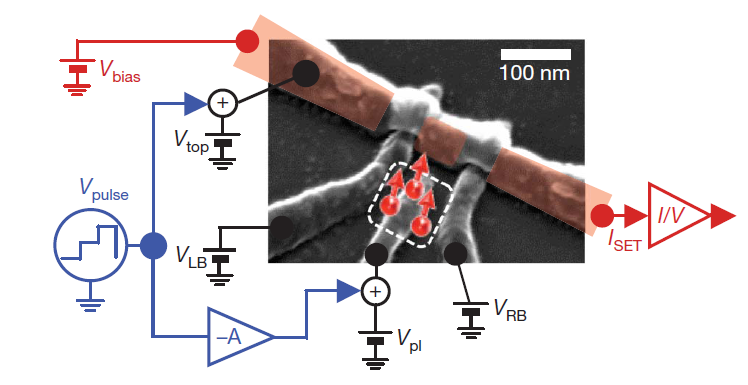Quantum computers are so highly sought after because they can solve complex mathematical problems and parallel computer operations such as code breaking really fast. Attempts to build quantum computers come in many flavours and use different kinds of quantum states, ranging from trapped atoms, superconductors to semiconductors such as gallium arsenide or diamond. The approach with diamond is particularly promising as it uses the spin of an electron to perform quantum computing operations, which means that such devices could be nicely tied in with conventional electronics and its control of electron transport itself.

Reading single spins. The information of a single spin in a reservoir can be read by a silicon single electron transistor island. Reprinted by permission from Macmillan Publishers Ltd. Nature (2010). doi:10.1038/nature09392
Now, Andrea Morello, Andrew Dzurak and colleagues from the University of New South Wales in Sydney in collaboration with researchers from Melbourne and Aalto University in Finland have achieved a major step towards such quantum computers using the most straightforward electronic material available: silicon. In a paper in Nature they demonstrate the reading of a single electron’s spin with a silicon electronic circuit. “Until this experiment, no-one had actually measured the spin of a single electron in silicon in a single-shot experiment,” says Morello. Ronald Hanson from the TU Delft, who works on the competing approach using impurities within diamond, agrees: “this is a result that the silicon quantum computing community has been waiting for for a long time.”
The principle of how the electron spin is read with a silicon circuit is relatively straightforward. It uses a charge reservoir, where the electrons are stored in phosphorus impurities that are implanted into the silicon. Next to the reservoir is a single electron transistor, which is a tiny silicon transistor that can detect the presence of a single electron.
Although the transistor is sensitive to a single electron, for a spin read-out the detection of the spin orientation of an electron in the reservoir is necessary. This can be done with electric voltages that can be separately applied to the island (red in Fig. 2) and the charge reservoir (blue). The different voltages shift the relative energy levels of the spin reservoir and the island. Like the flow of water at a lock in a canal, this controls the flow of electrons from left to right or vice versa.

The actual layout of the read-out circle. Electrons are stored in the reservoir (dashed white square), and read by the adjacent transistor (red shaded square). Reprinted by permission from Macmillan Publishers Ltd. Nature (2010). doi:10.1038/nature09392
First, the voltage of the spin reservoir is lowered. This means that electrons can flow into the reservoir (dashed white square). At this stage, the electron spin stored in the phosphorus atoms is random and not known.
If however, a magnetic field is applied, electrons with a spin in direction of the magnetic field (blue, downwards in Fig. 1) have a lower energy than those pointing in opposite direction. If now the read-out voltage of the island is set such that the energy level of the transistor is right between the energy of these two spin states, then a current can only flow from reservoir to the transistor if the spin points upwards (has the higher energy). And this is exactly what the researchers observed.
Although such experiments are still far away from the complexities of modern computer processors, the technology is readily scalable to a large number of devices says Morell. “The fabrication of the devices is compatible with the current semiconductor industry processes. Therefore, once a small-scale silicon quantum computer is demonstrated, we can expect the ability to scale it up and mass-produce it in partnership with existing facilities.”
And of course, this present demonstration is only one aspect of a quantum computer — reading out its information. What remains missing are elements to write information, and those that do the actual quantum operations. Consequently, fabricating the write elements is the next step. “We are now working on the demonstration of the other essential step for a quantum bit, i.e. the ability to ‘write’ an arbitrary state. The ‘read’ must necessarily come first, otherwise you would never know if you’ve written the right thing!” says Morello.
Looking at his own research on diamond-based elements for quantum computing, Hanson is confident that this study will kick off a fast-paced development for silicon-based quantum computing elements. “For single spin systems in diamond and in gallium arsenide, the ability to address a single spin opened the door to a wealth of new experiments. I believe the same will happen in the silicon community.”
For now, however, Hanson and colleagues that work on related semiconductor devices made from diamond or gallium arsenide can stay relaxed as these still have the edge over silicon. They are about five years ahead in the development, and both, spin reading and writing have already been demonstrated with impurity centres in diamond. And contrary to the extremely low temperatures that Morello are using, their diamond devices work at room-temperature. But that doesn’t mean that silicon is out of the game. The first conventional transistors were made by germanium, only to be superseded by silicon a few years later. Both, silicon and diamond have a lot going for them, and advances in either field can only benefit the wider quest to finally build a usable quantum computer.
Reference:
Morello, A., Pla, J., Zwanenburg, F., Chan, K., Tan, K., Huebl, H., Möttönen, M., Nugroho, C., Yang, C., van Donkelaar, J., Alves, A., Jamieson, D., Escott, C., Hollenberg, L., Clark, R., & Dzurak, A. (2010). Single-shot readout of an electron spin in silicon Nature DOI: 10.1038/nature09392
Further reading:
Awschalom, D. D., Epstein, R., & Hanson, R. (2007). The diamond age of spintronics. Scientific American 297, 84-91


Trackbacks/Pingbacks
[…] single excess electron, its spin, can be used for new types of quantum computing. Indeed, I have previously blogged about such efforts from another research group in Sydney using multiple phosphorus atoms for […]